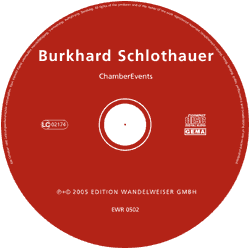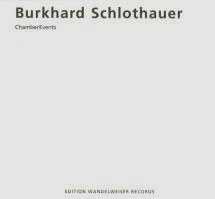EDITION WANDELWEISER RECORDS
> CD catalogue
> Burkhard Schlothauer
_____________________________________________________________________
<< >>
Burkhard Schlothauer
ChamberEvents
| order
reference:
medium: composer: performer: |
EWR
0502 CD Burkhard Schlothauer Zeitkratzer Ensemble Jongah Yoon, piano; Jürg Frey, bass clarinet Antoine Beuger, flute; Burkhard Schlothauer, clarinet; Craig Shepard, trombone |
 |
 |
ChamberEvents The works on this CD represent three different series of compositions, which I have been working on simultaneously in the last few years. Structurally, their individual parts resemble each other: all instruments play (rather) long sounds, each one followed by a pause. 55 similar events plus two drummers drumming (1999) consists of two layers of events. On the one hand, seven instruments are organized ‘isophonically’ and with regular durations. Their sounds, each comprising the same six pitches throughout the piece, start and end together. Each sound lasts about eight seconds and is followed by a pause of about four seconds. Each of these sounding events is differently orchestrated, the pitches being randomly assigned to the instruments. In each sound all the pitches are present, some of them occurring more than once. Traditional conceptions of musical composition focussing on pitch, would consider this to be 55 identical sounds. But in fact, because of their fundamental differences in terms of colour, of pitch weight within each sound, and of spatial location, they are not identical at all. Similarity produces difference. Parallel to and structurally independent from this, two percussionists play passages from two drummers drumming (1998). They have their own tempo. Two event levels coincide; relations are constructed. In the other two pieces on this CD, duration is organized in a fundamentally different way. Here, the durations of the sounds and the pauses are determined both by the activity and the physical constitution of the player and by the physical nature of the instrument, not by abstract periodical constructions. In aus atem (1994), for example, the player uses parts of his (individual) breath capacity as a measure for the duration of each tone, while in ab tasten (1995) the lengths of the tones depend on the different decay rate of the unmuted piano strings. At least one string is allowed to resonate until the sound dies away. The other strings are muted using the mechanics of the piano, for which highly detailed instructions for finger activity and pedalling are given. The length of the pauses is based on the duration of the tone preceding a pause. Both pieces belong to a series of solo pieces which can be combined with one another. Each of these pieces contains 121 sounds (ab tasten has 66 sounds), which may be played in any order without repetition. On this record events # 5 (3 bass clarinets, 2 pianos) is realized as a montage of recordings published earlier (EWR 9608 and EWR 0105). It is possible to understand the sound/pause sequences in this music as the extreme augmentation of a musical line. Seen this way, events # 5 (3 bass clarinets, 2 pianos) is based on a linear and, consequently, polyphonic conception, freed from any harmonic intention. A series of self-sufficient actions or activities of a player creates a chain of events, independent of the other parts. These then encounter each other randomly and, in apparent simultaneity, merge into a single complex sound. Not remaining the same, they develop a new and unexpected coherence and may be reinterpreted as one singular event. Bunkermusik (2003) was written on invitation of Munich based artist Christoph Nicolaus for a series of performances in a World War II bunker, where its first performance and the recording session took place. The tones a-d-g#, played throughout by flute, clarinet and trombone, are microtonally varied. The piece has 18 sections of ten minutes each. In each of the sections the sound is played in a different octave position an width but in the same order. Each note lasts one full breath, and the subsequent pause allows the performer to relax. In organic microtonal polyphonia (2003/2005), the compositional principles of the other pieces on this CD are combined: it is intentional with respect to the sound; on the other hand it is non-intentional with respect to the microtonal linear variations of the three instrumental parts. In the course of the piece, sections from Bunkermusik, here reduced to only five minutes, are superimposed to form two, three or five layer structures successively: so, in the last quarter of the piece, we can hear up to fifteen parts simultaneously. The steady fluctuation of the ‘asymmetric polyphony’ causes a ongoing aperiodical oscillation between consonance and dissonance, between ‘tension’ and ‘relaxation’ – a distant echo of an old harmonic principle in a non-intentional context. Burkhard Schlothauer |
> top